The face inversion effect, wherein people are better at identifying faces when they are oriented upright than when they are inverted, is one of many pieces of evidence that suggest faces are a special category of visual stimuli (there is no ‘inversion effect’ for everyday objects, scenes, or bodies). In addition to this distinct cognitive signature for face processing, neuroimaging studies have characterized a specialized facial recognition pathway in the brain. A prior fMRI study found that activation in the Fusiform Face Area (FFA) was significantly decreased when faces were presented inverted versus when the participants saw the same faces in their canonical upright orientation. However, these results must be interpreted with caution because the authors reported that the behavioral task used in this experiment was more difficult during the inverted face trials than during the upright face trials. Thus, it is not clear whether the FFA is the neural correlate of the face inversion effect. Here, we will manipulate task difficulty in an fMRI paradigm to test whether the FFA is indeed the neural correlate of the face inversion effect, or if another face-selective region is responsible for this well-known phenomenon.
PRESENTER: TITLE: AUTHORS:
Jessica Pei The Effect of Aging on Motor Memory Formation After Training Jessica Pei, Emory University; Julianne. J. Freeman, BS, Emory University; Cathrin M. Buetefisch, MD, PhD, Emory University
Studying motor learning in healthy subjects is important for stroke rehabilitation research because motor learning and motor recovery share common mechanisms. Since most stroke patients are older, available results of motor learning studies in younger subjects may not apply to the stroke population. Here we explored effects of age on motor learning in 16 healthy subjects (10 younger, 18-30 years; 6 older, 50-80 years). All subjects underwent motor training consisting of right wrist extension movements to move a cursor to a target box on a screen in front of the subject. Motor performance and primary motor cortex (M1) excitability (stimulus response curve (SRC)) were measured before and after training. SRC was collected by applying transcranial magnetic stimulation (TMS) to the corresponding left M1 hotspot at increasing intensities of stimulator output. At each intensity, motor evoked potential (MEP) amplitude was determined. M1 excitability was expressed as area under SRC. Motor learning was defined as increases in M1 excitability and peak velocity of wrist extension movements. All subjects learned the task but younger subjects demonstrated greater training related increases in peak wrist velocity (824.38 to 950.90 m/s (SE 76.06 and 57.86)) compared to older subjects (641.79 to 751.74 m/s (SE 73.08 and 57.86)).
